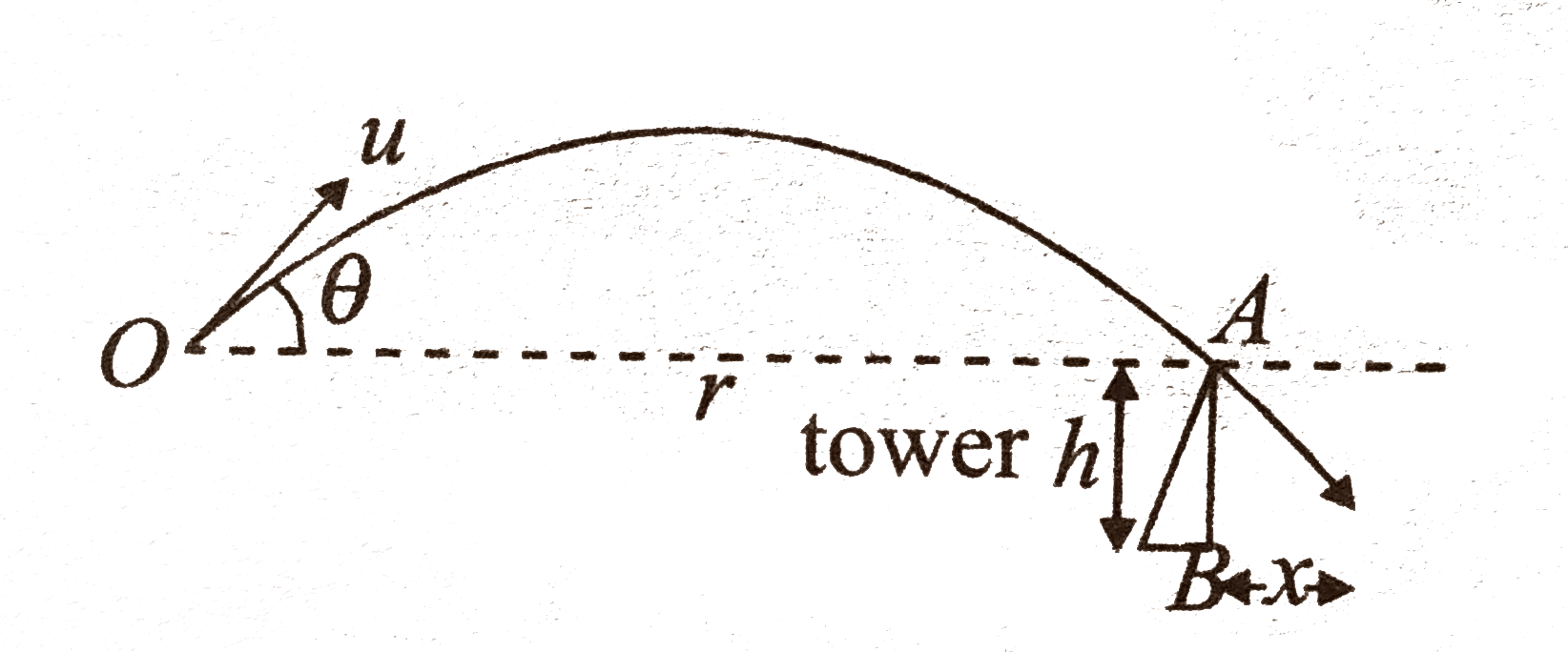A ball of mass 2Kg charge 1μC is dropped from top of a high tower.In space electric field exists in horizontal direction away from the tower which varies as
E=(5−2x)×106Vm−1 .Find maximum horizontal distance that the ball can go from the tower.
To solve the problem of finding the maximum horizontal distance that a ball of mass 2 kg and charge 1 µC can travel when dropped from a tower in a varying electric field, we can follow these steps:
Step 1: Identify the Electric Force
The electric force F acting on the ball due to the electric field E is given by:
F=Q⋅E
where Q is the charge of the ball and E is the electric field strength.
Given:
- Q=1μC=1×10−6C
- E=(5−2x)×106V/m
Thus, the electric force can be expressed as:
F=(1×10−6)⋅(5−2x)×106=(5−2x)N
Step 2: Calculate the Acceleration
The acceleration a of the ball can be found using Newton's second law:
F=m⋅a⟹a=Fm
where m is the mass of the ball.
Given:
- m=2kg
Thus, the acceleration is:
a=(5−2x)2m/s2
Step 3: Relate Acceleration to Velocity
We know that acceleration can also be expressed as:
a=dvdt=vdvdx
Thus, we can set up the equation:
dvdt=(5−2x)2
Step 4: Integrate to Find Velocity
To find the maximum distance, we need to integrate the acceleration with respect to displacement. Rearranging gives:
vdvdx=(5−2x)2
Integrating both sides:
∫v0dv=∫x0(5−2x)2dx
Step 5: Solve the Integral
The left side integrates to:
v
The right side integrates to:
12(5x−x2)∣∣x0=12(5x−x2)
Setting the equation:
v=12(5x−x2)
Step 6: Find Maximum Distance
To find the maximum distance, we need to set the velocity v to zero:
0=12(5x−x2)
This simplifies to:
5x−x2=0⟹x(5−x)=0
The solutions are:
- x=0 (initial position)
- x=5 (maximum distance)
Thus, the maximum horizontal distance that the ball can go from the tower is:
5m
The electric force F acting on the ball due to the electric field E is given by:
F=Q⋅E
where Q is the charge of the ball and E is the electric field strength.
- Q=1μC=1×10−6C
- E=(5−2x)×106V/m
F=(1×10−6)⋅(5−2x)×106=(5−2x)N
The acceleration a of the ball can be found using Newton's second law:
F=m⋅a⟹a=Fm
where m is the mass of the ball.
- m=2kg
a=(5−2x)2m/s2
We know that acceleration can also be expressed as:
a=dvdt=vdvdx
Thus, we can set up the equation:
dvdt=(5−2x)2
To find the maximum distance, we need to integrate the acceleration with respect to displacement. Rearranging gives:
vdvdx=(5−2x)2
Integrating both sides:
∫v0dv=∫x0(5−2x)2dx
The left side integrates to:
v
The right side integrates to:
12(5x−x2)∣∣x0=12(5x−x2)
Setting the equation:
v=12(5x−x2)
To find the maximum distance, we need to set the velocity v to zero:
0=12(5x−x2)
This simplifies to:
5x−x2=0⟹x(5−x)=0
The solutions are:
- x=0 (initial position)
- x=5 (maximum distance)
5m
Topper's Solved these Questions
- ELECTROSTATICSBOOK - VMC MODULES ENGLISHCHAPTER - ELECTROSTATICSEXERCISE - LEVEL - 2
60 Videos
- ELECTROSTATICSBOOK - VMC MODULES ENGLISHCHAPTER - ELECTROSTATICSEXERCISE - JEE MAIN
65 Videos
- ELECTROSTATICSBOOK - VMC MODULES ENGLISHCHAPTER - ELECTROSTATICSEXERCISE - LEVEL - 0 (LONG ANSWER TYPE )
8 Videos
- ELECTROMAGNETIC INDUCTION & ALTERNATIVE CURRENT BOOK - VMC MODULES ENGLISHCHAPTER - ELECTROMAGNETIC INDUCTION & ALTERNATIVE CURRENT EXERCISE - IMPECCABLE
52 Videos
- ENERGY & MOMENTUMBOOK - VMC MODULES ENGLISHCHAPTER - ENERGY & MOMENTUMEXERCISE - JEE ADVANCE (ARCHIVE) - TRUE/FALSE TYPE
1 Videos
Similar Questions
A ball of mass 1 kg is dropped from a tower. Find power of gravitational force at time t=2s. Take g=10m/s^(2).
View SolutionA body is dropped from the top of a tower. It acquires a velocity 20 m s−1 on reaching the ground. Calculate the height of the tower. (Take g = 10 m s−2)
View SolutionA ball is dropped from the top of a tower. After 2 s another ball is thrown vertically downwards with a speed of 40ms−1. After how much time and at what distance below the top of tower the balls meet ?
View SolutionA ball is thrown from a point in level with velocity u and at a horizontal distance r from the top os a tower of height h.
At what horizontal distance x from the foot of the tower does the ball hit the ground ?
View SolutionA charged particle of mass m = 2 kg and charge 1μC is projected from a horizontal ground at an angle θ=45∘ with speed 10ms−1. In space, a horizontal electric field towards the direction of projection E=2×107NC−1 exists. The range of the projectile is
View SolutionA 20 m high vertical pole and a vertical tower are on the same level ground in such a way that the angle of elevation of the top of the tower, as seen from the foot of the pole, is 60∘ and the angle of elevation of the top of the pole as seen from the foot of the tower is 30∘ . Find :
the horizontal distance between the pole and the tower.
View SolutionA ball of mass m having a charge q is released from rest in a region where a horizontal electric field E exists.
(a) Find the resultant force acting on the ball.
(b) Find the trajectory followed by the ball.
View SolutionA ball is thrown from the top of a 35m high tower with initial velocity of magnitude u=80 ms−1 at an angle 25∘ with horizontal.
Find the time to reach the ground and the horizontal distance covered by the ball.
View SolutionA ball is thrown from the top of a 35m high tower with initial velocity of magnitude u=80 ms−1 at an angle 25∘ with horizontal.
Find the time to reach the ground and the horizontal distance covered by the ball.
View SolutionA particle is dropped from the top of a tower. Its covered distance in last 1 sec is equal to distance covered by particle in 1st3s. Find height of tower.
View Solution
